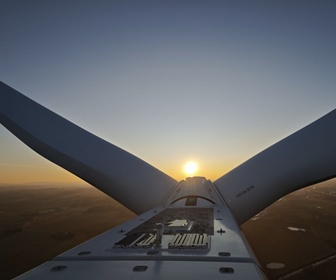 I am always curious to know how much the cost of generating electricity with a wind turbine is, how much revenue it generates and how the financial balance works out. It is very interesting to know, and to compare the numbers for electricity from wind with those from other sources. After all, if the numbers work out right, then the direction to go is more evident. It seems, however, that there is never a reasonable answer to these questions.
I am always curious to know how much the cost of generating electricity with a wind turbine is, how much revenue it generates and how the financial balance works out. It is very interesting to know, and to compare the numbers for electricity from wind with those from other sources. After all, if the numbers work out right, then the direction to go is more evident. It seems, however, that there is never a reasonable answer to these questions.By Ahmad Hemami, McGill University, Montreal, Canada
Obviously, one cannot expect to see clear-cut numbers, since there are many factors involved. But even accepting some degree of uncertainty and a reasonably wide range of numbers and taking into account the many differences that can exist between countries or regions in terms of the relevant policies and ways of living, there still exists a lot of confusion.
For the relevant numbers in the USA, I always refer to those provided by the Department of Energy through its research and development laboratories, such as NREL (National Renewable Energy Laboratory) since it continuously follows up the same question with extensive searches and updates. Nonetheless, there is still something that does not make sense to me, as explained shortly. I tried to see if there are similar sources for the same type of analysis for European countries, but surprisingly I found myself facing more questions than answers.
I expected that everywhere the cost of (electrical) energy depends on the sources (gas, oil, hydro, etc.) used to generate electricity and that wind energy must be competitive with it to be attractive. This competitive cost could include the contribution from subsidies by local governments. However, it seems that this is not the way it works. As for the European countries, I found a listing of electricity cost to household consumers (Not the real production cost) very different from one country to the other. For instance, for the month of February 2023, the numbers range from € 0.044 to € 0.499 per kWh, with an average of € 0.283. [1] This is a difference of more than 10 times. On the other hand, based on another source showing that the average monthly wholesale prices for the day ahead had significantly dropped in May 2023, the commercial price of electricity in Europe can be seen. As an example, the corresponding figure for Belgium is € 80.1/MWh (−24%). According to the previous document, which shows € 0.35/kWh for Belgium, the household consumer is charged € 350/MWh. Putting aside the argument of why there should be such a big difference (80 versus 350) between the buying and selling prices, it can be understood that the cost of production is less than € 80/MWh. [2]
Going back to the cost of wind energy production in the USA, according to the NREL report the levelized cost of wind energy for utility-scale land-based wind farms is $ 34/MWh. Similar figures for fixed-bottom and floating offshore production are, respectively, $ 78 and $ 133. From the viewpoint of cost competition and a cheaper price tag, this does not make sense, since the reason for going offshore is mainly to benefit from stronger and steadier wind and using larger turbines, leading to a more competitive price. From the technical and operations viewpoints, it is obvious that offshore wind farms are much more costly compared with land-based farms. Probably this can work out only if government support allows it and absorbs the shortfall.
It is very promising if now governments in industrial countries have realised that care for the environment is of paramount importance, and the future of the Earth and life on it depend on the correct actions now, if it is not already too late. For many years scientists and experts have signalled the danger and have called for action. At least a call for net-zero emissions has now entered the mandate and the course of action of some governments.
The recent year-to-year changes in the weather pattern and climate cannot be ignored. If they continue with the same exponential pattern, then the consequences are even worse and irreversible. In addition to flooding in various parts of the world, in 2023 we have had extensive and record-breaking wildfires, some of them for the first time, such as those in islands of Greece and Hawaii, which could happen in other places in the coming years. In 2022, in Canada, there were a total of 4,883 forest fires (much more than previous years). In 2023, not yet out of the season, we already have 5,650 (as of 11 August) fires, burning 33.30 million acres of valuable green forests [4].
The recent year-to-year changes in the weather pattern and climate cannot be ignored. If they continue with the same exponential pattern, then the consequences are even worse and irreversible. In addition to flooding in various parts of the world, in 2023 we have had extensive and record-breaking wildfires, some of them for the first time, such as those in islands of Greece and Hawaii, which could happen in other places in the coming years. In 2022, in Canada, there were a total of 4,883 forest fires (much more than previous years). In 2023, not yet out of the season, we already have 5,650 (as of 11 August) fires, burning 33.30 million acres of valuable green forests [4].
Rising temperatures as a result of these fires has a positive feedback effect (meaning it accelerates the temperature rise and causes more damage to the environment) in addition to other adverse side effects on the ecosystem. I wonder what the year 2050, the target year for net-zero emissions, will look like.
Further Reading:
Further Reading:
- Yanatma, S. March 2023. https://www.euronews.com/next/2023/03/29/energy-crisis-in-europe-which-countries-have-the-cheapest-and-most-expensive-electricity-a
- Yermolenko, H. June 2023. https://gmk.center/en/posts/european-electricity-prices-fell-significantly-in-may/
- Stehly, T. and Duffy, P. December 2022. 2021 Cost of Wind Energy Review. National Renewable Energy Laboratory. https://www.nrel.gov/docs/fy23osti/84774.pdf
- https://en.wikipedia.org/wiki/2023_Canadian_wildfires








